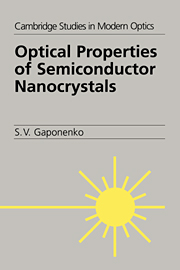Book contents
- Frontmatter
- Contents
- Preface
- 1 Electron states in crystal
- 2 Electron states in an ideal nanocrystal
- 3 Growth of nanocrystals
- 4 General properties of spectrally inhomogeneous media
- 5 Absorption and emission of light by semiconductor nanocrystals
- 6 Resonant optical nonlinearities and related many-body effects
- 7 Interface effects
- 8 Spatially organized ensembles of nanocrystals
- References
- Index
4 - General properties of spectrally inhomogeneous media
Published online by Cambridge University Press: 09 October 2009
- Frontmatter
- Contents
- Preface
- 1 Electron states in crystal
- 2 Electron states in an ideal nanocrystal
- 3 Growth of nanocrystals
- 4 General properties of spectrally inhomogeneous media
- 5 Absorption and emission of light by semiconductor nanocrystals
- 6 Resonant optical nonlinearities and related many-body effects
- 7 Interface effects
- 8 Spatially organized ensembles of nanocrystals
- References
- Index
Summary
Because of inevitable size distribution, shape variations, different concentration of impurities and defects, and fluctuations of local environment and charge distribution, every ensemble of nanocrystals dispersed in some solid or liquid medium possesses inhomogeneously broadened absorption and emission spectra. Therefore, a number of properties inherent in molecular and atomic inhomogeneously broadened spectra can be a priori foreseen for nanocrystals. These include spectral hole-burning, fluorescence line narrowing under selective excitation, and decay time distribution. At the same time, spectrally selective techniques developed for inhomogeneously broadened molecular and atomic structures have been successfully applied to nanocrystals providing evaluation of individual parameters smeared as a result of inhomogeneous broadening. This chapter gives a brief overview of specific phenomena inherent in all spectrally inhomogeneous media and a survey of the relevant experimental techniques including nonlinear pump-and-probe spectroscopy, fluorescence excitation spectroscopy, and single molecule spectroscopy.
Population-induced optical nonlinearity and spectral hole-burning
Every real system consisting of particles with discrete energy levels exhibits absorption saturation under intense optical excitation. The only example of a nonsaturable system is an ensemble of ideal harmonic oscillators that possess an infinite number of equally spaced energy levels, optical transitions allowed only for a couple of neighboring levels, and the probability of optical transitions being proportional to the level number (Stepanov and Gribkovskii 1963).
- Type
- Chapter
- Information
- Optical Properties of Semiconductor Nanocrystals , pp. 72 - 83Publisher: Cambridge University PressPrint publication year: 1998



